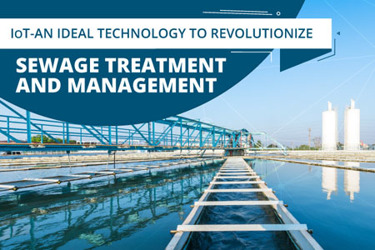IoT — An Ideal Technology To Revolutionize Sewage Treatment And Management
By Sanjeev Verma

With freshwater sources depleting rapidly, treating and consuming wastewater seems to be the only option in the near future. As per a UN population fund released in 2001, it was estimated that the world will start facing water-related issues by 2050.
However, given the current numbers — 3.8 billion (58 percent of global population) living under water stress in the 2000s1 — the impact of water scarcity is quite visible in the present as well. So, even if we don’t use treated wastewater for drinking and other household purposes, it’s high time that we start consuming it for industrial applications.
But there are several challenges associated with wastewater treatment to be resolved.
According to an estimate by the U.S. EPA, approximately 23,000 to 75,000 sewers overflow every year. Also, anywhere around 2 to 10 billion gallons of untreated wastewater is released from water treatment plants that contaminate or pollutes freshwater bodies.
One of the main factors that leads to such circumstances is the unpredictability of surge or dip in wastewater levels in sewage. Weather conditions and sudden water releases can affect levels in sewer lines that can make it very difficult for treatment facilities to prevent overflows.
By leveraging industrial-grade solutions within the Internet of Things (IoT), wastewater treatment facilities can effectively track the level of wastewater in sewage lines and prevent overflow conditions. Let’s see how.
IoT-Powered Sewage Monitoring Solutions
While there are systems like SCADA that can help water treatment and distribution facilities to monitor sewage, their installation can be very difficult and thus their application is limited.
IoT, due to its wireless architecture and monitoring capabilities, is a better alternative than SCADA and a perfect fit for wastewater treatment facilities to manage sewers and prevent overfills.
As a communication medium, this technology allows the collection of data points from physical end nodes as well as transfer through a wireless channel to a computer with intelligent data analyzing capabilities.
The data point can be anything from the level of water in sewage to the pressure at which it is flowing. By keeping a track of these parameters, the amount of wastewater flowing through sewer lines can be effectively monitored at all times, which allows treatment facilities to take immediate countermeasures to prevent overfills if one such condition arises.
This data can be collected on an application and web-powered platform, which makes data accessible from any remote location.
Furthermore, this real-time data, when gathered for a long duration, can be tabulated and analyzed to identify major causes that lead to sewage overflows. Additionally, this data can also be computed and analyzed in the form of charts, tables, and illustrations for easy visualization.
When processed using advanced analytics and algorithm sequences, the data can help identify the major causes of overflows — for example, blockages, leaking pipes, power outages at pump stations, or inadequate carrying capacity.
Benefits Of Using IoT For Sewage Monitoring
- Reduced inspection time:
Since IoT leverages real-time telematics and enables shared data from devices located at extreme endpoints, it becomes simpler for operators to pinpoint the exact location affected by overfilling. Hence, time that is generally wasted to inspect a place and identify the cause of sewage clogging is considerably reduced.
- Expandable to other solutions:
IoT technology is quite modular and flexible. It can be configured for any solution and collect data points for any parameter. By using several sensors, variables other than the level and volume of wastewater in sewage lines can be effectively monitored — such as water quality and its constituents.
Parameters like total dissolved solids (TDS), pH, salinity, etc., and their amount or degree of concentration, can be identified. Hence, these facilities can measure how much the water is contaminated and subsequently use effective procedures like disinfection, ion exchange, filtration, etc. to clean it.
Subsequently, the quality of water and the residual elements left in them after being treated can also be measured through this solution. This helps the treatment facilities to calculate the efficiency of their processes and optimize them to clean wastewater better.
- Leak detection:
Wastewater treatment facilities collect wastewater and deliver the treated water through their pipeline network that expands for miles. However, these pipelines often leak, affecting the biodiversity and infrastructure (like roads) around the pipelines.
By using an IoT-based leak detection solution, wastewater management facilities can identify the pipelines that leak and subsequently take the necessary steps to replace them with new pipes.
Conclusion
The adverse impact of releasing wastewater into the environment can be reduced by instead utilizing it for industry, where water is a major resource due to its capabilities as a coolant and perfect solvent, among other uses.
Although there are challenges associated with sewage management and wastewater treatment, IoT-based technology overcomes these obstacles to allow for treated water to be used where it is well-suited and greatly needed, within industrial settings.
 Sanjeev Verma is the founder and CEO of Biz4Group, based out of Orlando, FL. He has conceptualized the idea of Biz4 Brand and founded Biz4Group and Biz4Intellia. He has 20+ years of experience in boosting IT-based startups to success. In the past, he has worked on leadership positions with Marriott Vacations, Disney, Mastercard, State Farm, and Oracle. The company headed by him excels in developing, implementing, and monitoring digital solutions ranging from IoT solutions and products, mobile and web development, and digital marketing to full stack development and CMS solutions.
Sanjeev Verma is the founder and CEO of Biz4Group, based out of Orlando, FL. He has conceptualized the idea of Biz4 Brand and founded Biz4Group and Biz4Intellia. He has 20+ years of experience in boosting IT-based startups to success. In the past, he has worked on leadership positions with Marriott Vacations, Disney, Mastercard, State Farm, and Oracle. The company headed by him excels in developing, implementing, and monitoring digital solutions ranging from IoT solutions and products, mobile and web development, and digital marketing to full stack development and CMS solutions.
1. Kummu, M. et al. The world’s road to water scarcity: shortage and stress in the 20th century and pathways towards sustainability. Sci. Rep. 6, 38495; doi: 10.1038/srep38495 (2016)
